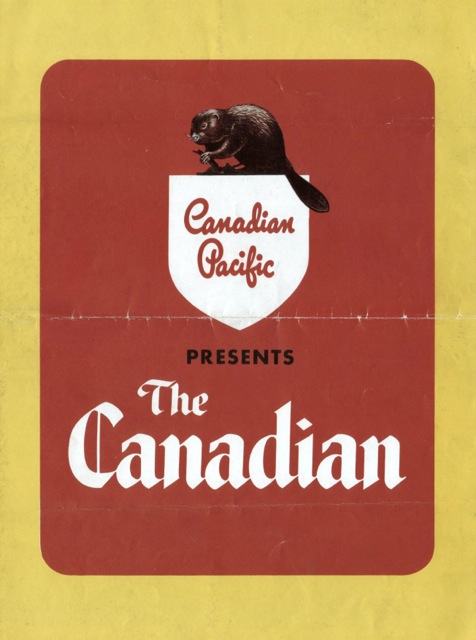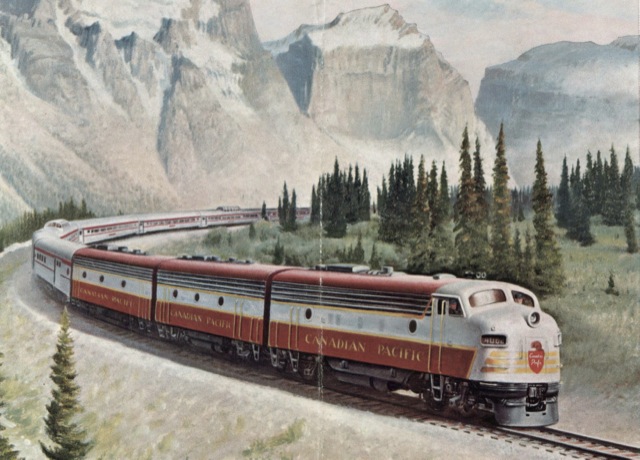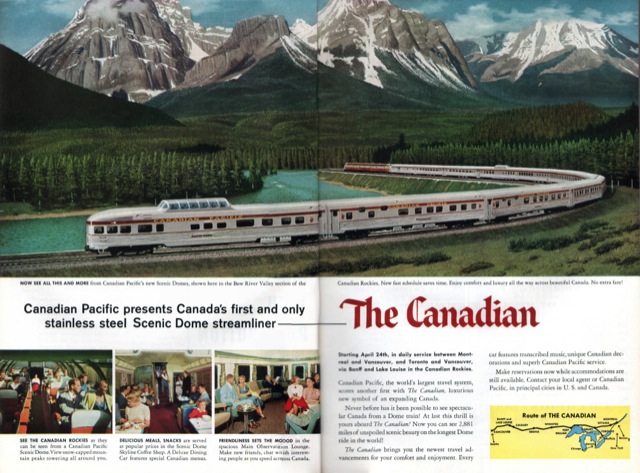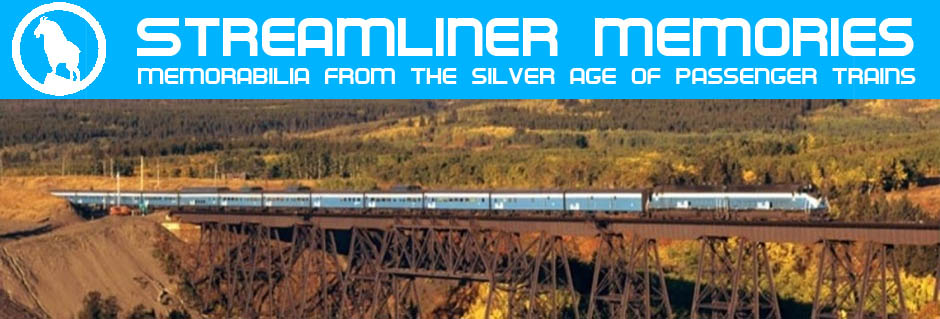Canada was late to the streamliner revolution. Canadian National was still using steam locomotives to pull its premiere heavyweight trains as late as 1954. Canadian Pacific had at least Dieselized its trains, but continued to use a mix of heavyweight and streamlined cars in Tuscan red paint for its premiere train, the Dominion.

Click to download a 6.8-MB PDF of this brochure introducing the Canadian.
That changed on April 24, 1955, when Canadian Pacific introduced the Canadian, a (mostly) Budd-built stainless steel train with two dome cars. The new train traveled from Montreal and Toronto to Vancouver about 16 hours faster than the Dominion, which CPR kept on its old schedule to serve small towns where the Canadian would not stop. Even on the faster timetable, the Canadian averaged only about 40 mph.
The first dome in the train was the Skyline car, which was patterned after the California Zephyr dome-cafe car except that it had coach seats in the long end of the car in place of the CZ‘s crew dormitory. The cafe portion of the car included murals and paintings, some of which were done by Pierre Bourdelle. The Canadian Pacific ordered 18 of these dome cars so it would have enough to equip the Toronto and Montreal sections of the train (which split in Sudbury, Ontario), with enough dome cars left over for the Dominion and the overnight Atlantic Limited between Montreal and St. Johns, New Brunswick.

The illustrations in this brochure were done by an artist named Hedley Rainnie. This illustration shows two Skyline cars in the train, indicating either that Rainnie wasn’t aware of how CPR planned to operate the train or that operations were not yet jelled when the drawing was made.
The second dome was the Park-series observation car, also patterned after the CZ observation cars. Like the CZ cars, the Park cars each had three bedrooms and a drawing room in front of the dome; a bar and lounge with about 12 seats under the dome; and another lounge behind the dome with about 14 seats. Each Park car was named after a Canadian national park and the lounges of each car were decorated with murals done by a different Canadian artist featuring scenes from that particular park. The artists were each paid $1,400 (about $12,000 in today’s money) for their work. Like the Skyline cars, there were 18 cars in the Park series as well as 18 stainless steel diners.
In addition to the Park cars, the train included three kinds of sleeping cars. First were the “Manor” series of cars, which contained four roomettes, five double bedrooms, a compartment, and four sections (eight beds), for a total of 24 beds. The Canadian Pacific had 42 of these cars. The second was the Chateau series, which contained 8 duplex roomettes, 1 drawing room, three double bedrooms, and 4 sections, for a total of 25 beds. For some reason, CPR felt that 29 of this type of car would be sufficient.

The tourist sleepers were never shown in illustrations of the train, such as the one used in this two-page ad in the April, 1955 National Geographic. Click image for a larger view.
Finally, the Canadian typically carried “tourist sleepers,” heavyweight cars that had been painted silver to roughly match the stainless steel, that contained 14 sections (28 beds). These cars cost less than the sections in the Chateau or Manor cars, but their passengers did not have access to the Park-series dome. The tourist sleepers were located right behind the baggage cars presumably because they did not contain public address system equipment and a location elsewhere in the train would interrupt PA service to part of the train.
A typical Canadian consisted of the baggage car, two or three tourist sleepers, two to four 60-seat coaches (of which CPR owned 30), the Skyline car, four Manor cars, three Chateau cars, and a Park car. Assuming six sets of equipment were needed for the Canadian and eight for the Dominion, CPR had plenty of diners, Skyline, and Park cars for both trains but not always enough coaches and sleepers, so it used a mix of heavyweight and streamlined cars for the slower train.
